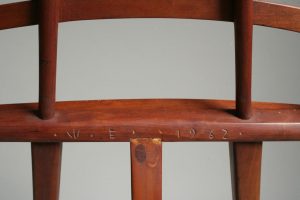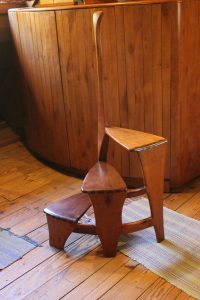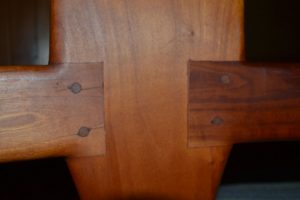
Wharton Esherick was a terrible joiner. He hated the joinery aspect of woodworking, and it shows. Even on his iconic pieces, Wharton spent more time on the form and how it looked rather than on how it was stuck together. So, like it or not, I’m going to pick apart the joinery of Wharton Esherick.
I’m not bringing this up to bash on Esherick. I like some of his stuff enough to make my versions of it in the shop. In fact, you may recall an adaptation of his stool I made in the June 2014 issue of Popular Woodworking Magazine. I’m a fan. But that doesn’t mean I can’t take an honest look at the craftsmanship behind the artistry, critique it and use those lessons to improve my work.
Joinery and Wharton Esherick

The opening photo in this post is a close-up of the apron to leg joint on a triangular-based table. I’ll concede there are seldom great methods for joining triangle-based tables. Merely beveling the end of the apron, screwing it to the leg, plugging the hole and puttying the gaps, probably isn’t one of the better solutions. A spline near the back of the apron, mortised into the leg would have provided, at least, a little side-grain to side-grain gluing surface.
I mentioned earlier that Esherick’s lack of attention to joinery spilled over from his minor pieces to some of his most successful designs as well. When looking at two of his most famous creations, the music stand, and library steps, it’s easy to see the problems. The central leg on the music stand, for instance, is cut off at an angle and gained into the bottom of the sheet music support. Two pocket screws pass through the leg into the support to hold the joint together. A single or double through tenon(s) would have significantly increased the strength of the joint.
Joining Esherick’s Library Steps

The library steps have curved stretchers between the risers. Each of the stretchers is merely lapped into the riser, glued and pegged. Esherick is relying solely on the glue and pegs to hold the joints together. Switching to a mortise and tenon might have proved reasonably challenging to get a tight looking joint. But, if you enlarge the pic of the lap joints, you’ll see he didn’t seem to mind joint gaps anyway.
I’m not to saying Esherick was a complete slouch when it came to joinery (or rather the cabinetmakers in his shop weren’t). Dovetails were employed where practical and necessary. And there are plenty of examples where he used mortise-and-tenon joints. Sometimes in the same piece as poorer techniques. Once again, the library steps are a perfect example.
While the stretchers are lapped in and waiting for the glue to fail, the treads are joined to the central support using through mortise-and-tenon joints. The tenons are even wedged making for a robust and longlived joint.
And if you’d like to build an Esherick piece with proper joinery, use the coupon code day5 (valid for the next 72 hours) at checkout to receive a 10% discount on the Esherick Stool class. Look closely at the stool and notice the sculpted joints. Esherick made the piece in 1929. Take that Sam Maloof.


If you’d like to learn more about Wharton Esherick and his woodworking click the links below: